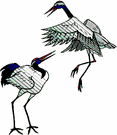Black Phoebes have babies

After watching the pair of Black Phoebes on my friend's farm near Canon City bringing food to a likely nest site several days ago, I didn't see them attending to the nest since then. The reason became clear when I found a family of Black Phoebes this afternoon foraging about a 100 feet from the likely nest location (this fits timing-wise with fledging occuring on Sunday 5-28 as this would be 3 days, the time period associated with fledglings and adults moving away from the nest site per Birds of North America). The parents were apparently showing the fledglings how to forage as they were all flying around some trees near the river; and they were all quite vocal.
This photo is of one of the fledglings the brownish wash and edgings on juvenal feathers show. There are at least 2, but possibly 3, fledglings (hard to pin them down when they are flying about in the foliage especially when they moved to the overhanging vegetation on the river banks).
In past years the female has re-nested soon after the fledglings gain their independence. It will be interesting to see if this occurs this year.
SeEtta
























